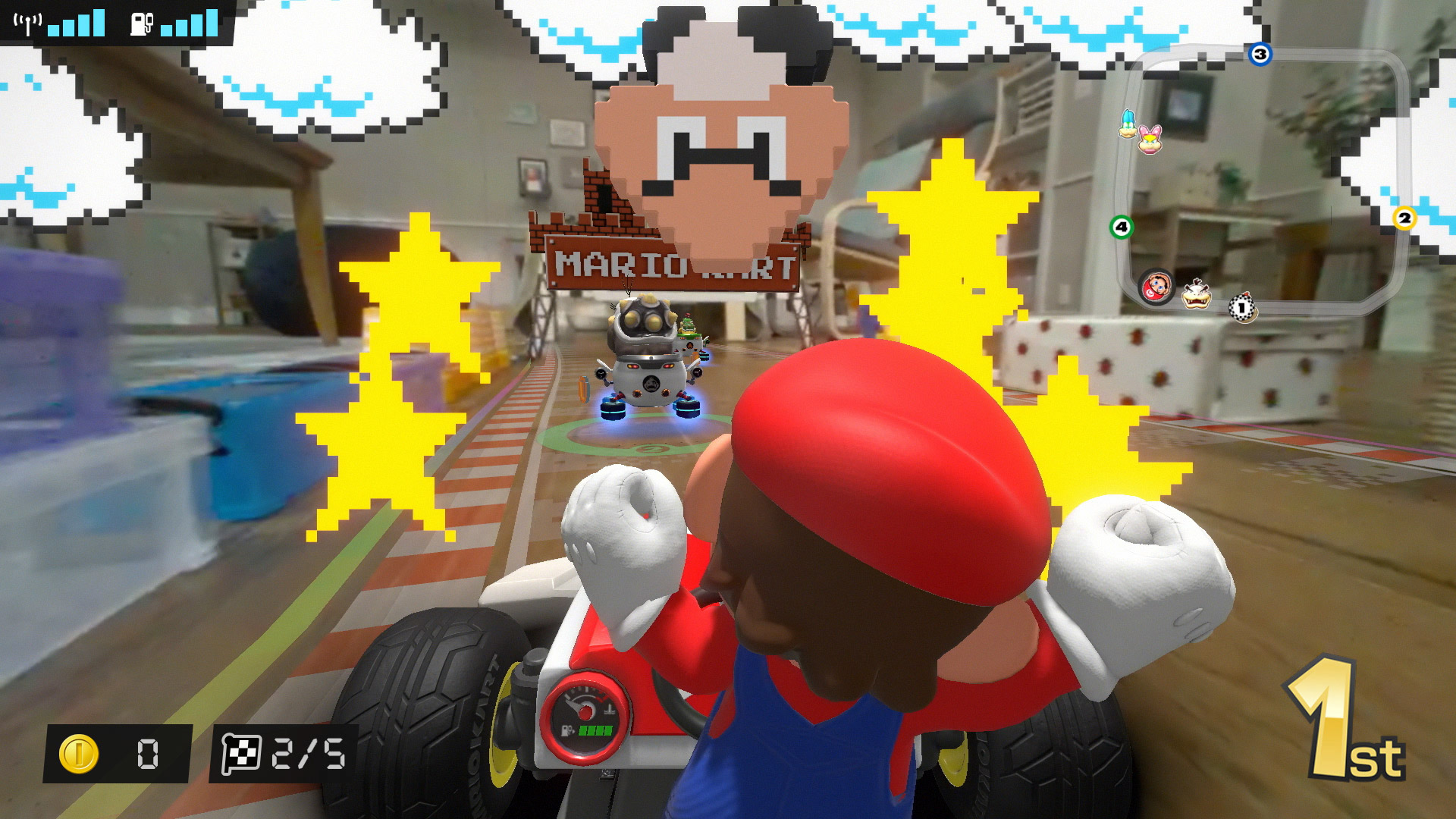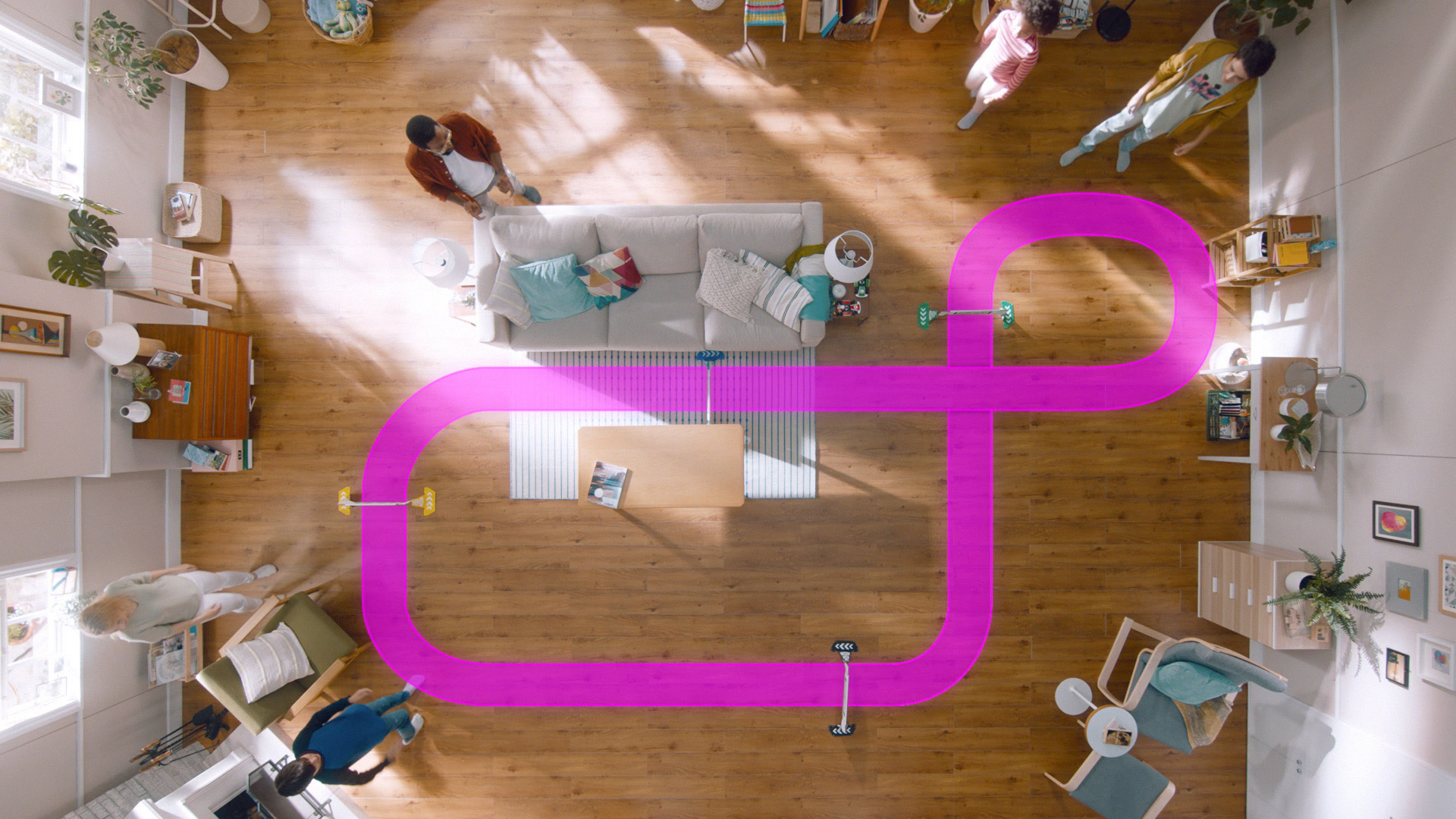Mario Kart Live: Home Circuit Isn’t a Proper New Mario Kart Game—And That’s Okay
When Nintendo first announced Mario Kart Live: Home Circuit, I didn’t pay it much attention—to the point that I can’t even remember when or how Nintendo revealed the game. As bits and pieces of additional knowledge found their way into my head, it sounded like a cute idea in a long line of Nintendo gimmick products, but maybe not much more than that.
However, one of the joys of this job is being forced to actually pay attention to something I might not otherwise pay attention to. When Nintendo offered to send EGM a Mario Kart Live: Home Circuit set to check out, that task quickly fell onto my shoulders, given I’m the one with the most potential space to set it up. And, to be fair, I had grown more curious as time went on.
Space is a concern with Home Circuit because, unlike all other chapters of the franchise up until now, the game’s races play out in real life as they also unfold on screen. The centerpiece of this project is a little plastic kart replica that’s basically the modern-day equivalent of an RC car. Thanks to a digital camera that sits just over Mario’s head, as you drive the real-world kart around your house or apartment, you see what lies before the kart on the screen of your Switch or Switch Lite. And then, using augmented reality, a second virtual world gets layered atop the feed of the real world—and thus, a game is born.
For the first day after I received Mario Kart Live: Home Circuit, I never once touched the actual game portion of the game. Instead, I simply raced Mario around the main floor of my house, to the utter delight of my twins. In some moments, they would chase Mario; in others, he would chase them. Every day since, one or both of them will come up and say, “What about Mario Kart?” in hopes that he’ll be free to play with them at some point before bedtime.
I actually think that was a perfect way to get me introduced to Home Circuit before jumping into the game proper, because it gave me the chance to get to know the physical kart and its limitations without any race-related pressures. In theory, there’s nothing in what Nintendo has built here that we haven’t seen before, and yet I still can’t help but feel some amazement at the functionality. Being able to drive a remote-controlled car around via a handheld video game system, and race around parts of my house I can’t directly see with my own eyes thanks to the camera, is cool. Also, the kart is way more robust than I was expecting, from its build quality (I’ve crashed it into walls and objects countless times), to its ability to handle carpet and smaller obstacles, to the speeds it can reach once you unlock the game’s higher CC classes. Nintendo could possibly sell me just on the cart without any actual game attached—though I don’t know that the current price tag of $99.99 would be justifiable at that point.
However, Mario Kart Live: Home Circuit does also come with a game, and it’s one that requires a bit of effort to play. Given you’re actually racing a small-scale kart around real locations, the amount of room you have to give to a track limits its potential length. Included in the box are four cardboard gates, and these are one of the only real restrictions you have when designing a course. At some point, Mario will have to drive through all four from a direction where the camera can properly see the gate, and you’ll then need to be able to repeat the loop, as there are no one-and-done courses here. Once you’ve placed the gates, you’ll do an initial drive around the area to chart the course for your track, and that’s all pretty much up to you.
If you want to keep things simple, you can make a basic circle and call it a day. If you want to get more creative, you can race down a hallway, carve a path through a toy-filled bedroom, head back to the living room, zip around some dining room chairs, use the underside of your couch as a makeshift tunnel, and then make the connection to your starting point. The hiccups here come in how you’ve planned things out in conjunction with real-world objects, which the game has no real way of knowing exist. For example, in my first course, I cut too close to a couch leg when charting the path, so that when the game created the track virtually, said leg was right in the middle of the road. That can especially be a problem because your rivals in the game—Bowser Jr. and the Koopalings—have no concern for such obstacles. Their virtual karts can drive along your created tracks while only needing to care about in-game setbacks like banana peels, red turtle shells, or environmental hazards, while you’ll need to contend both with those and that couch leg your physical kart keeps bumping into.
There’s one other setback to Mario Kart Live: Home Circuit, and it affects both gameplay sessions and those times when you’re chasing two-year-old daughters around the house after dinner. Nintendo clearly sees this as an experience you’ll have when playing the game in the same room where you’ve set the physical course up, but even then, I had instances where the connection between the system and the physical kart grew unstable, which then had a direct effect on the game. My initial understanding was that my Switch and the kart would connect via our home WiFi, but it seems like it’s definitely important to keep both in close proximity to each other as much as possible. Even when doing so, however, I still had a time or two where a couch or wall could cause lag or noise in the feed. Most of the time, it wasn’t an issue when playing Mario Kart Live: Home Circuit properly—but it did crop up far more often when I just wanted to explore around from room to room. I know Nintendo may not intend for this to be a longer-range RC car equivalent, but no matter what they intend, end users are going to want that. So, I do wish Nintendo had pushed the tech just a little bit farther in that regard.
What I don’t wish, though, is that Nintendo had scraped Mario Kart Live: Home Circuit for a “proper” new chapter of the Mario Kart franchise, as I’ve seen some fans suggest.
Look, I understand. I really do. While Mario Kart 8 Deluxe is a great game in its own right, there’s no denying that it’s an upgraded version of Mario Kart 8 from the Wii U—meaning we haven’t had that proper new chapter in six years now. Given the immense popularity of the Switch, there’s a whole lot of fans who want a new Mario Kart that takes full advantage of the system’s power while also offering a fresh racing experience. Almost four years in, we still don’t have that, so it can sting to instead see a product like this that seems to just be a new fad.
And yet, even with the hassle of setting up courses, the restrictions on who will be able to properly utilize the game (due to those physical space requirements), the technical shortcomings, and the somewhat shallower gameplay given the lack of track variations due to the limitations of AR, there’s something absolutely special about Mario Kart Live: Home Circuit. After I’d gotten everything set up and played my first race, I felt like a kid again, discovering some crazy new video game I never could have imagined before. Even now, after having spent a week with the game, the magic still hasn’t worn off. I haven’t always understood or cared about Nintendo’s side projects, as goofy gimmicks and one-off products can make it seem like someone at the company is continually throwing ideas at a wall to see which stick. Sometimes, though, the team at Nintendo comes up with an idea that’s brilliant, and in those moments, I appreciate their messy walls.
Even before I’d felt it for myself, it was watching my twins chase Mario around that the excitement of Mario Kart Live: Home Circuit first started to hit me. There’s just something about having a tangible thing that can exist outside of the screen (beyond static figures or content-unlocking collectables), and watching Mario and his little plastic kart racing around added a new dimension to everything. Sure, in the grand scheme of things, my daughters are still too young to fully appreciate Home Circuiton a video game level, but through their reaction, I understood how much of a kick bigger kids are going to get. (Especially when you factor in the ability to add a second set for multiplayer.)
I definitely don’t dream of a world where every game becomes some AR-powered “experience” that holds back gameplay potential for the benefit of real-world connections, but damn if I’m not convinced—perhaps for the first time ever—that AR can be a powerful new option for our favorite hobby. And, even if most of the video game that comes from that must adhere to the rules of what the physical kart can do, there’s still moments where the connection between the two caught me off guard. Maybe it was something as simple as seeing the kart come to a dead stop after a turtle shell hit me in-game, or something more advanced, like the kart’s wheels continually shifting to simulate the effects of the strong winds blowing on the course I was playing. The full Mario Kart that fans know and love might not exist here, but there’s still a lot of Mario Kart-ness to be found in ways that were never possible before.
So, no, Mario Kart Live: Home Circuit isn’t a proper new Mario Kart game—and that’s okay.




